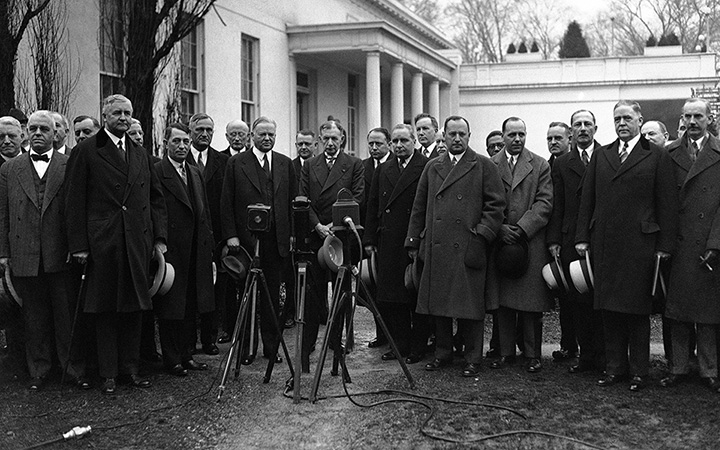Banking Act of 1932
February 27, 1932

The Banking Act of 1932, also known as the Glass-Stegall Act of 1932, reformed the Federal Reserve's role in providing credit during economic downturns.1 The act included two principal provisions. One, the Reserve banks received authority to lend to member banks on assets not otherwise eligible for discount, with the approval of five members of the Federal Reserve Board and at an interest rate at least one-half of 1 percent higher than the highest regular discount rate in effect at that Reserve bank. Two, the Reserve banks received authority to use government securities as collateral for Federal Reserve notes in addition to gold and commercial paper, which were the types of collateral authorized by the Federal Reserve Act. Both provisions expired after one year, although subsequent legislation extended these temporary provisions, which eventually became permanent.
The impetus for the act came from the governors of the Federal Reserve Board (Eugene Meyer) and the Federal Reserve Bank of New York (George Harrison).2 In January 1932 the pair became convinced that the Federal Reserve Act should be amended to enable the Federal Reserve to lend to members on a wider range of assets and thereby increase the supply of money in circulation. The supply of money was limited by laws that required the Federal Reserve to back money in circulation with gold held in its vaults. Gold supplies had fallen since the summer of 1931. Governors and directors of several Reserve Banks worried about their free-gold positions and stated this concern several times in the latter part of 1931 and early 1932 (Chandler 1971, 186).
Meyer and Harrison met with bankers in New York and Chicago to discuss these issues and gain their support. Then, the pair approached the Hoover administration and Congress. Sen. Carter Glass initially opposed the legislation because it conflicted with his commercial loan theory of money creation, but after discussions with the president, secretary of treasury, and others, eventually agreed to co-sponsor the act. About these discussions, Herbert Hoover wrote,
A funny thing about this act is that though its purpose was to avoid imminent disaster, the economy being by now in a state of collapse, the objection was raised that it would be inflationary. This was as if a doctor with a dying patient on his hands should refrain from giving him proper treatment for fear if he got well he might do something foolish. Senator Glass had this fear and was zealous to prune back the "inflationary" possibilities of the measure (Hoover 1952, 117).
Within a few days of the passage of the act, the Federal Reserve unleashed an expansionary program that was, at that time, of unprecedented scale and scope. The Federal Reserve System bought nearly $25 million in government securities each week in March and nearly $100 million each week in April. By June, the System had purchased over $1 billion in government securities. These purchases offset huge flows of gold to Europe and hoarding of currency by the public, so that in summer of 1932 deflation ceased. Prices of commodities and securities had begun to return to pre-depression levels. Industrial production had begun to recover. The economy appeared headed in the right direction (Chandler 1971; Friedman and Schwartz 1963; Meltzer 2003).
In the summer of 1932, however, the Federal Reserve discontinued its expansionary policies and ceased purchasing substantial quantities of government securities. "It seems likely that had the purchases continued, the collapse of the monetary system during the winter of 1933 might have been avoided" (Meltzer 2003, 372-3).
Endnotes
- 1 The Banking Act of 1932 was originally known as the Glass-Steagall Act. In 1932, the Federal Reserve Bulletin, newspapers, and congressional documents referred to the act with that label. The Banking Act of 1933, however, was also sponsored by Sen. Carter Glass and Henry Steagall, and four provisions from that act that limited commercial banks' activities in securities markets and relationships with investment banks have come to be commonly called the Glass-Steagall legislation. Now the Glass-Steagall label is seldom used for the earlier legislation.
- 2 The authors' account of the genesis of the Banking Act of 1932 is based on Chandler (1971).
Bibliography
Butkiewicz, James L. "The Impact of a Lender of Last Resort During the Great Depression: the Case of the Reconstruction Finance Corporation." Explorations in Economic History 32, no. 2 (April 1995): 197-216.
Chandler, Lester V. American Monetary Policy, 1928 to 1941. New York: Harper and Row, 1971.
Crum, W. L. and J.B. Hubbard. "Review of the First Quarter of 1932." Review of Economics and Statistics 14, no. 2 (May 1932): 66-73.
Ebersole, J. Franklin. "One Year of the Reconstruction Finance Corporation." Quarterly Journal of Economics 47, no. 3 (May 1933): 464-92.
Federal Reserve Board. Federal Reserve Bulletin, February 1932. Available on FRASER.
Federal Reserve Board. Federal Reserve Bulletin, March 1932. Available on FRASER.
Friedman, Milton and Anna Schwartz. A Monetary History of the United States: 1867-1960. Princeton: Princeton University Press, 1963.
Harris, S.E. "Banking and Currency Legislation, 1932." Quarterly Journal of Economics 46, no. 3 (May 1932): 546-57.
Hoover, Herbert. The Memoirs of Herbert Hoover: The Great Depression, 1929 to 1941. New York: Macmillan Company, 1952, p. 117.
Jones, Jesse H. Fifty Billion Dollars: My Thirteen Years with the RFC (1932-1934). New York: Macmillan Company, 1951.
Mason, Joseph. "The Political Economy of RFC Assistance during the Great Depression." Explorations in Economic History 40, no. 2 (April 2003): 101-21.
Mason, Joseph. "Do Lender of Last Resort Policies Matter? The Effects of Reconstruction Finance Corporation Assistance to Banks During the Great Depression." Journal of Financial Services Research 20, no. 1 (September 2001): 77-95.
Meltzer, Allan. A History of the Federal Reserve: Volume 1, 1913 to 1951. Chicago: University of Chicago Press, 2003.
New York Times. "Hearings Are Begun On Credit Pool Bill." December 19, 1931.
New York Times. "The Finance Corporation's Program." February 10, 1932.
Written as of November 22, 2013 as part of the essay "Banking Acts of 1932" and revised as of January 2022 with research from David C. Wheelock. Please cite this essay as "Banking Act of 1932." Federal Reserve History, January 2022. See disclaimer and update policy.

 X
X  facebook
facebook
 email
email